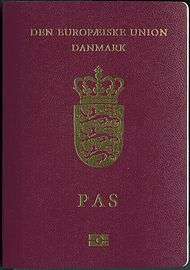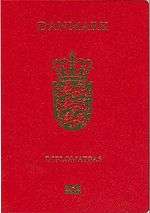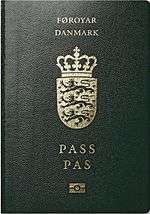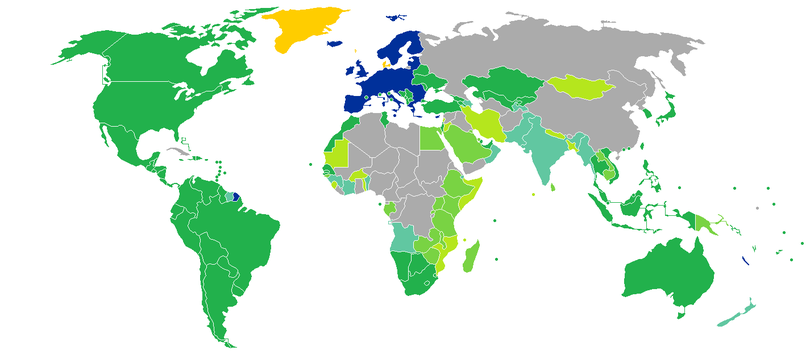Danish passport
Danish passports are issued to citizens of the Kingdom of Denmark (Danish: Kongeriget Danmark) to facilitate international travel.
| Danish passport | |
|---|---|
 The front cover of a contemporary Danish biometric passport | |
| Type | Passport |
| Issued by | |
| First issued | 1 August 2006[1] (biometric passport) 1 January 2012[2] (current version) |
| Purpose | Identification |
| Eligibility | Citizens of the Kingdom of Denmark |
| Expiration | 2 years and 4 months for children up to the age of 1 5 years and 4 months for citizens aged 2–17 10 years and 4 months for individuals above the age of 18 (All passports can be renewed for 1 year within 2 years of original expiration date) |
| Cost |
|
Different versions exist for nationals of Denmark, Greenland, and the Faroe Islands although all citizens have the same nationality. Danish nationals residing in Greenland can choose between the Danish EU passport and the local Greenlandic passport.[4]
Every Danish citizen (except for those residing in the Faroe Islands) is also a citizen of the European Union. The passport entitles its bearer to freedom of movement in the European Economic Area, Switzerland and the United Kingdom.
According to the January 2019 Visa Restrictions Index, Danish citizens can visit 187 countries without a visa or with a visa granted on arrival.
Physical appearance
The Danish and Greenlandic versions of the passport have burgundy colour covers, according to the European Union's recommendations, while the Faroese version is green. All contain the Danish Coat of Arms emblazoned in the centre of the front cover, with the word DANMARK (Denmark) above it, and the word PAS (Passport) below. Since 1 August 2006, biometric passports are issued. Above the word DANMARK, the Danish version contains the words DEN EUROPÆISKE UNION (European Union) (as all other EU passports), while in the Greenlandic and Faroese versions the text KALAALLIT NUNAAT (Greenland) or FØROYAR (Faroe Islands) is written. Fields on the bearer's page are in Danish, English, and French, with translations in the official languages of the European Union elsewhere in the document. Instead of French, Faroese or Greenlandic are used in the Faroese and Greenlandic versions respectively. The page contains the following information:[5]
- Photo of the passport holder
- Type (P)
- Passport No.
- Surname
- Given names
- Sex
- Nationality (Danish: Dansk, Danish, French: Danoise)
- Height
- Date of Birth
- Personal Code Number
- Place of Birth
- Date of issue/expiry (validity is 10 years from date of issue for adults and 5 years for children)
- Authority (usually the municipality in which the holder resides)
- Holder's signature
Passports contain a machine readable strip starting with P>DNK for all types.



Different spellings of the same name
Names containing special letters (æ, ø, å) are spelled the correct way in the non-machine-readable zone, but are mapped in the machine-readable zone, æ becoming AE, ø becoming OE, and å becoming AA. This follows the international machine-readable passport standard.
For example, Gråbøl → GRAABOEL.
Types
Besides the ordinary passport (with PAS on the cover), also 3 versions of blue service passports (TJENESTEPAS) and a single red diplomatic passport (DIPLOMATPAS) are issued. The latter does not bear the text DEN EUROPÆISKE UNION.
Visa requirements

In January 2020, Danish citizens had visa-free or visa on arrival access to 187 countries and territories, thus ranking the Danish passport fifth in the world (tied with the passports of Luxembourg and Spain) according to the Visa Restrictions Index.[8] According to the World Tourism Organization 2016 report, the Danish passport is first in the world (tied with Finland, Germany, Italy, Luxembourg, Singapore, and the United Kingdom) in terms of travel freedom, with the mobility index of 160 (out of 215 with no visa weighted by 1, visa on arrival weighted by 0.7, eVisa by 0.5 and traditional visa weighted by 0).[9]
Controversy
In 2010, an atheist Danish citizen filed a complaint to the Danish Ministry of Justice, due to the passport's inclusion of a picture of the crucifixion of Jesus as shown on the Jelling Stones, arguing that passports should be free of religious symbols.[10] This argument was rejected by leading Danish politicians, arguing that Christianity is a part of Denmark's cultural history, and Christianity was not depicted exclusively, since the passport also includes an image of a dragon motif, likewise taken from the largest Jelling Stone.[11] The passport design including images from the Jelling Stones was introduced in 1997,[12] when the current red design was introduced. Previous Danish passports had been green or beige.
Lack of National identity card
EU rules allow any citizen of a member country to travel anywhere in the EU without a passport, if they have a national identity card stating citizenship and some other standardised information. Denmark and Ireland are the only EU countries that do not issue national identity cards however Ireland issues passport cards which are treated by law as ID cards by some EU countries, therefore Denmark is the only country in the EU which solely does not have the possibility of any form of ID card travel. There has been some political support for introducing such cards since the EU rule was introduced, but this has not yet become a reality.[13]
See also
External links
- European Community Passport (1989 — 1999) Description and images.
References
- "Council of the European Union - PRADO - DNK-AO-04001". consilium.europa.eu. Retrieved 1 August 2017.
- "Council of the European Union - PRADO - DNK-AO-05001". consilium.europa.eu. Retrieved 1 August 2017.
- "Passport – Greenlandic and Danish". Sullissivik. Retrieved 17 February 2015.
- "Council of the European Union - PRADO - DNK-AO-05003". www.consilium.europa.eu.
- "Council of the European Union - PRADO - DNK-AO-05002". www.consilium.europa.eu.
- "Council of the European Union - PRADO - DNK-AO-05003". www.consilium.europa.eu.
- https://www.henleypassportindex.com/assets/2020/Q1/HENLEY%20PASSPORT%20INDEX%202020%20Q1%20INFOGRAPHIC%20GLOBAL%20RANKING_191219.pdf
- "Visa Openness Report 2016" (PDF). World Tourism Organization. Archived from the original (PDF) on 23 January 2016. Retrieved 23 January 2016.
- "Complaint over passport Jesus". Danmarks Radio website. 4 March 2010. Retrieved 17 July 2010.
- "Jesus skal blive i det danske pas". Dagbladet Information (in Danish). 2 March 2010. Retrieved 4 September 2011.
- Adriansen, Inge (2003). Nationale symboler i det Danske Rige (in Danish). 2. Museum Tusculanums Forlag. p. 369.
- Flertal for nationalt ID-kort (b.dk 2004)